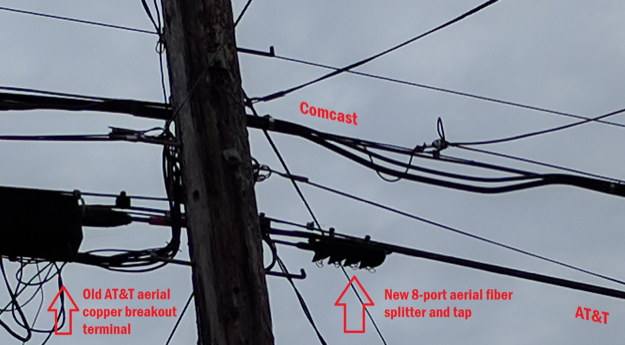
AT&T’s recent fiber to the home (FTTH) upgrades in Santa Cruz mean that Cruzio isn’t the only Internet service provider bringing gigabit class infrastructure into town (unless you have a sneaking suspicion that it’s a competitive response – in that case you can thank Cruzio for it too). U.C. Santa Cruz’s Jim Warner tracked it down…
AT&T has been working on an FTTH deployment in parts of west Santa Cruz. The work has progressed to the point where some addresses are showing availability of gigabit service in AT&T’s on-line service availability tool. When you enter a “good” address – one where gigabit service is already available – you see, among other things, a web offer for “fiber” service at 100 Mbps and 1,000 Mbps download and upload speeds (subject to the usual disclaimer: “actual customer speeds may vary and are not guaranteed”).
The 100 Mbps packages is capped at 1 terabyte a month; the gigabit package offers “unlimited data”.
An example of what FTTH looks like “on the pole” is in the picture above. The thin curved lines that appear to loop back into the new tap are not fibers. They are simply plastic retainers to keep the protective caps from falling to the ground. To be ready to serve any address, one of the taps needs to be placed on almost every pole.
It is harder to see what’s going on underground. We need to wait for details about the project to know if areas where utilities are underground (rather than on poles) will be included.
The quality of AT&T’s craftsmanship is highly variable and not all of it looks as clean as in the picture presented. So far, I’ve seen FTTH work in the area bounded by Walnut Ave., California St., Almar Ave. and King St. This is a poor way to gauge the scope of their project, though. I visited the AT&T retail store but discovered staff get no special advance information about what the company is working on.
Wireline carriers, such as AT&T and Comcast, each get one foot of vertical space on each pole for their service. AT&T has attached their new fiber network to their legacy copper network to avoid needing to completely rearrange the pole or pay for another foot of pole space.
